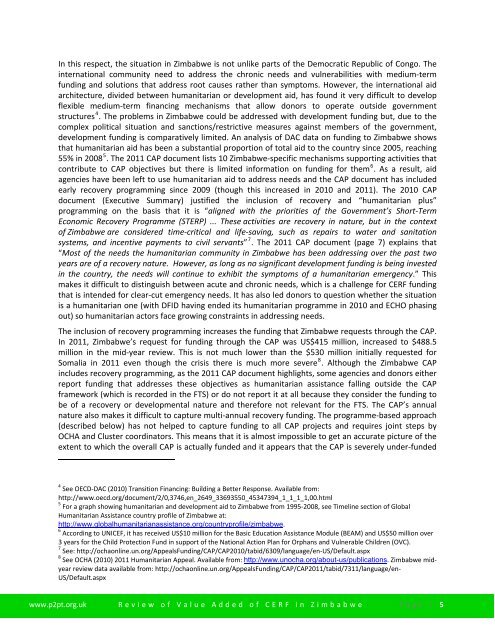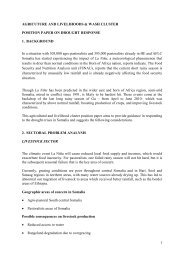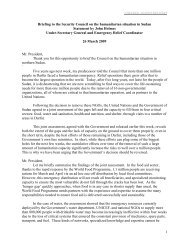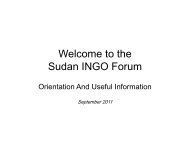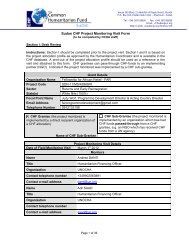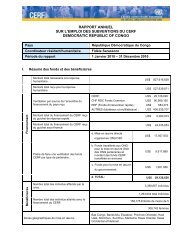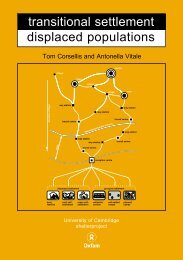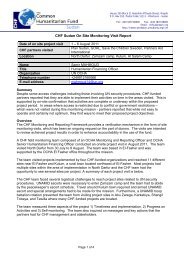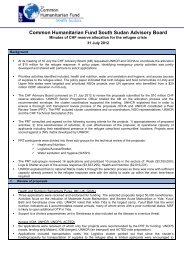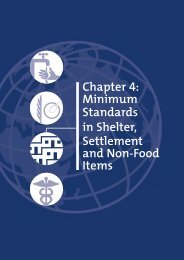in Zimbabwe - OCHANet
in Zimbabwe - OCHANet
in Zimbabwe - OCHANet
You also want an ePaper? Increase the reach of your titles
YUMPU automatically turns print PDFs into web optimized ePapers that Google loves.
In this respect, the situation <strong>in</strong> <strong>Zimbabwe</strong> is not unlike parts of the Democratic Republic of Congo. The<br />
<strong>in</strong>ternational community need to address the chronic needs and vulnerabilities with medium‐term<br />
fund<strong>in</strong>g and solutions that address root causes rather than symptoms. However, the <strong>in</strong>ternational aid<br />
architecture, divided between humanitarian or development aid, has found it very difficult to develop<br />
flexible medium‐term f<strong>in</strong>anc<strong>in</strong>g mechanisms that allow donors to operate outside government<br />
structures 4 . The problems <strong>in</strong> <strong>Zimbabwe</strong> could be addressed with development fund<strong>in</strong>g but, due to the<br />
complex political situation and sanctions/restrictive measures aga<strong>in</strong>st members of the government,<br />
development fund<strong>in</strong>g is comparatively limited. An analysis of DAC data on fund<strong>in</strong>g to <strong>Zimbabwe</strong> shows<br />
that humanitarian aid has been a substantial proportion of total aid to the country s<strong>in</strong>ce 2005, reach<strong>in</strong>g<br />
55% <strong>in</strong> 2008 5 . The 2011 CAP document lists 10 <strong>Zimbabwe</strong>‐specific mechanisms support<strong>in</strong>g activities that<br />
contribute to CAP objectives but there is limited <strong>in</strong>formation on fund<strong>in</strong>g for them 6 . As a result, aid<br />
agencies have been left to use humanitarian aid to address needs and the CAP document has <strong>in</strong>cluded<br />
early recovery programm<strong>in</strong>g s<strong>in</strong>ce 2009 (though this <strong>in</strong>creased <strong>in</strong> 2010 and 2011). The 2010 CAP<br />
document (Executive Summary) justified the <strong>in</strong>clusion of recovery and “humanitarian plus”<br />
programm<strong>in</strong>g on the basis that it is “aligned with the priorities of the Government’s Short‐Term<br />
Economic Recovery Programme (STERP) ... These activities are recovery <strong>in</strong> nature, but <strong>in</strong> the context<br />
of <strong>Zimbabwe</strong> are considered time‐critical and life‐sav<strong>in</strong>g, such as repairs to water and sanitation<br />
systems, and <strong>in</strong>centive payments to civil servants” 7 . The 2011 CAP document (page 7) expla<strong>in</strong>s that<br />
“Most of the needs the humanitarian community <strong>in</strong> <strong>Zimbabwe</strong> has been address<strong>in</strong>g over the past two<br />
years are of a recovery nature. However, as long as no significant development fund<strong>in</strong>g is be<strong>in</strong>g <strong>in</strong>vested<br />
<strong>in</strong> the country, the needs will cont<strong>in</strong>ue to exhibit the symptoms of a humanitarian emergency.” This<br />
makes it difficult to dist<strong>in</strong>guish between acute and chronic needs, which is a challenge for CERF fund<strong>in</strong>g<br />
that is <strong>in</strong>tended for clear‐cut emergency needs. It has also led donors to question whether the situation<br />
is a humanitarian one (with DFID hav<strong>in</strong>g ended its humanitarian programme <strong>in</strong> 2010 and ECHO phas<strong>in</strong>g<br />
out) so humanitarian actors face grow<strong>in</strong>g constra<strong>in</strong>ts <strong>in</strong> address<strong>in</strong>g needs.<br />
The <strong>in</strong>clusion of recovery programm<strong>in</strong>g <strong>in</strong>creases the fund<strong>in</strong>g that <strong>Zimbabwe</strong> requests through the CAP.<br />
In 2011, <strong>Zimbabwe</strong>’s request for fund<strong>in</strong>g through the CAP was US$415 million, <strong>in</strong>creased to $488.5<br />
million <strong>in</strong> the mid‐year review. This is not much lower than the $530 million <strong>in</strong>itially requested for<br />
Somalia <strong>in</strong> 2011 even though the crisis there is much more severe 8 . Although the <strong>Zimbabwe</strong> CAP<br />
<strong>in</strong>cludes recovery programm<strong>in</strong>g, as the 2011 CAP document highlights, some agencies and donors either<br />
report fund<strong>in</strong>g that addresses these objectives as humanitarian assistance fall<strong>in</strong>g outside the CAP<br />
framework (which is recorded <strong>in</strong> the FTS) or do not report it at all because they consider the fund<strong>in</strong>g to<br />
be of a recovery or developmental nature and therefore not relevant for the FTS. The CAP’s annual<br />
nature also makes it difficult to capture multi‐annual recovery fund<strong>in</strong>g. The programme‐based approach<br />
(described below) has not helped to capture fund<strong>in</strong>g to all CAP projects and requires jo<strong>in</strong>t steps by<br />
OCHA and Cluster coord<strong>in</strong>ators. This means that it is almost impossible to get an accurate picture of the<br />
extent to which the overall CAP is actually funded and it appears that the CAP is severely under‐funded<br />
4 See OECD‐DAC (2010) Transition F<strong>in</strong>anc<strong>in</strong>g: Build<strong>in</strong>g a Better Response. Available from:<br />
http://www.oecd.org/document/2/0,3746,en_2649_33693550_45347394_1_1_1_1,00.html<br />
5 For a graph show<strong>in</strong>g humanitarian and development aid to <strong>Zimbabwe</strong> from 1995‐2008, see Timel<strong>in</strong>e section of Global<br />
Humanitarian Assistance country profile of <strong>Zimbabwe</strong> at:<br />
http://www.globalhumanitarianassistance.org/countryprofile/zimbabwe.<br />
6 Accord<strong>in</strong>g to UNICEF, it has received US$10 million for the Basic Education Assistance Module (BEAM) and US$50 million over<br />
3 years for the Child Protection Fund <strong>in</strong> support of the National Action Plan for Orphans and Vulnerable Children (OVC).<br />
7 See: http://ochaonl<strong>in</strong>e.un.org/AppealsFund<strong>in</strong>g/CAP/CAP2010/tabid/6309/language/en‐US/Default.aspx<br />
8 See OCHA (2010) 2011 Humanitarian Appeal. Available from: http://www.unocha.org/about-us/publications. <strong>Zimbabwe</strong> midyear<br />
review data available from: http://ochaonl<strong>in</strong>e.un.org/AppealsFund<strong>in</strong>g/CAP/CAP2011/tabid/7311/language/en‐<br />
US/Default.aspx<br />
www.p2pt.org.uk Review of Value Added of CERF <strong>in</strong> <strong>Zimbabwe</strong> Page | 5


